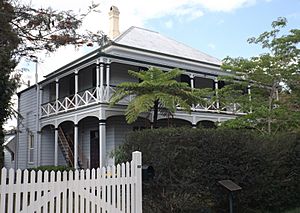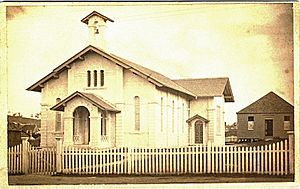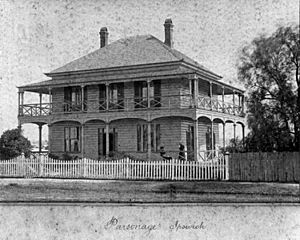Central Congregational Church Manse facts for kids
Quick facts for kids Central Congregational Church Manse |
|
|---|---|

Building in 2015
|
|
| Location | 21 Quarry Street, Ipswich, City of Ipswich, Queensland, Australia |
| Design period | 1870s–1890s (late 19th century) |
| Built | 1883 |
| Architect | Samuel Shenton |
| Official name: Central Congregational Church Manse | |
| Type | state heritage (landscape, built) |
| Designated | 21 October 1992 |
| Reference no. | 600594 |
| Significant period | 1880s (fabric) 1880s–1930s (historical) |
| Significant components | residential accommodation – manse, garden/grounds |
| Builders | Samuel Shenton |
| Lua error in Module:Location_map at line 420: attempt to index field 'wikibase' (a nil value). | |
The Central Congregational Church Manse is a special old house in Ipswich, Australia. It's known as a "manse," which is a home for a church minister or pastor. This building is listed on the Queensland Heritage Register, meaning it's an important historical site. It was designed and built in 1883 by a well-known architect named Samuel Shenton.
Contents
A Look Back: The Manse's History
This large, two-story timber house was built to be the home for the pastors of the Congregational Church in Ipswich. In 1883, while it was being built, people described it as a "two-storeyed weather-board house with verandah balcony all round." It had 12 rooms and was built to be a credit to the church.
Building the Manse
The Manse was designed and built by Samuel Shenton. He was an architect and builder, and also a member of the Congregational Church. The building cost over 1200 pounds at the time. Construction started and finished in 1883.
The Congregational Church in Ipswich
The Congregational Church in Ipswich started on June 2, 1854. It was a new church formed by two smaller groups, the Baptist and Independent faiths. This was because there weren't many people from each group in the early town of Ipswich. This Ipswich church was the very first Congregational parish in Queensland. It grew a lot across the state in the late 1800s. The church was very independent and didn't accept money or land from the government.
Early Church Buildings
In 1855, the first Congregational church building in Ipswich was constructed. It was a simple timber building on Brisbane Street. Samuel Shenton, who later designed the Manse, also built this first church.
In 1870, a new, larger church was built next to the old one. Samuel Shenton designed this one too. The old church then became a Sunday School. By this time, the church was known as the Central Congregational Church. This new church cost over 2,000 pounds. It stood until February 1953, when it was sadly destroyed by fire. The land where it stood is now a supermarket and car park.
Changes to the Manse Over Time
In 1936 and 1937, the Manse was sold by the Church. It was then changed into several smaller apartments or "flats." Later, in 1950, some of the land around the Manse was taken for road work. Other parts of the land were also divided up and sold.
Today, the outside of the Manse looks very much like it did in a photograph from 1896. The only real change is some extra vertical railings on the top floor. The Manse is the only building left that shows the work of the Central Congregational Church from the 1800s in Ipswich.
About Samuel Shenton
Samuel Shenton was one of the most important early architects in Ipswich. He arrived in Ipswich in 1851 and first worked as a carpenter. He built many important buildings in the city. In the 1860s, he made big improvements to central Ipswich, including the School of Arts and the Lands Office.
From 1879, Shenton worked only as an architect. His business was later taken over by George Brockwell Gill in 1889. Shenton was also very involved in the community and local government. He was an alderman (a local council member) for many years. He even served as the Mayor of Ipswich twice, from 1871 to 1872 and again in 1889. He passed away in Ipswich in 1893. One of his other famous buildings that still stands today is Faerieknowe.
Why the Manse is Important: Heritage Listing
The Central Congregational Church Manse was added to the Queensland Heritage Register on October 21, 1992. This means it's recognized as a very important historical place.
Historical Significance
The Manse is important because it shows how the Congregational Church grew in Ipswich and Queensland. This church was one of the first independent church groups in Queensland. Many Congregational churches later joined the Uniting Church in the 1900s. The Manse helps us understand how important churches were to communities in Queensland in the 1800s.
Architectural Design
The Manse is also a great example of the work of architect and builder Samuel Shenton. He was a leading architect in Ipswich from the 1850s to the 1880s.
Aesthetic Value
The Manse looks beautiful on the street. Its size, traditional materials, and detailed design make it a lovely part of the area.
Connection to People
The Manse has a special connection to the people who were part of the Congregational Church in Ipswich. It also reminds us of the pastors and their families who lived there long ago.





